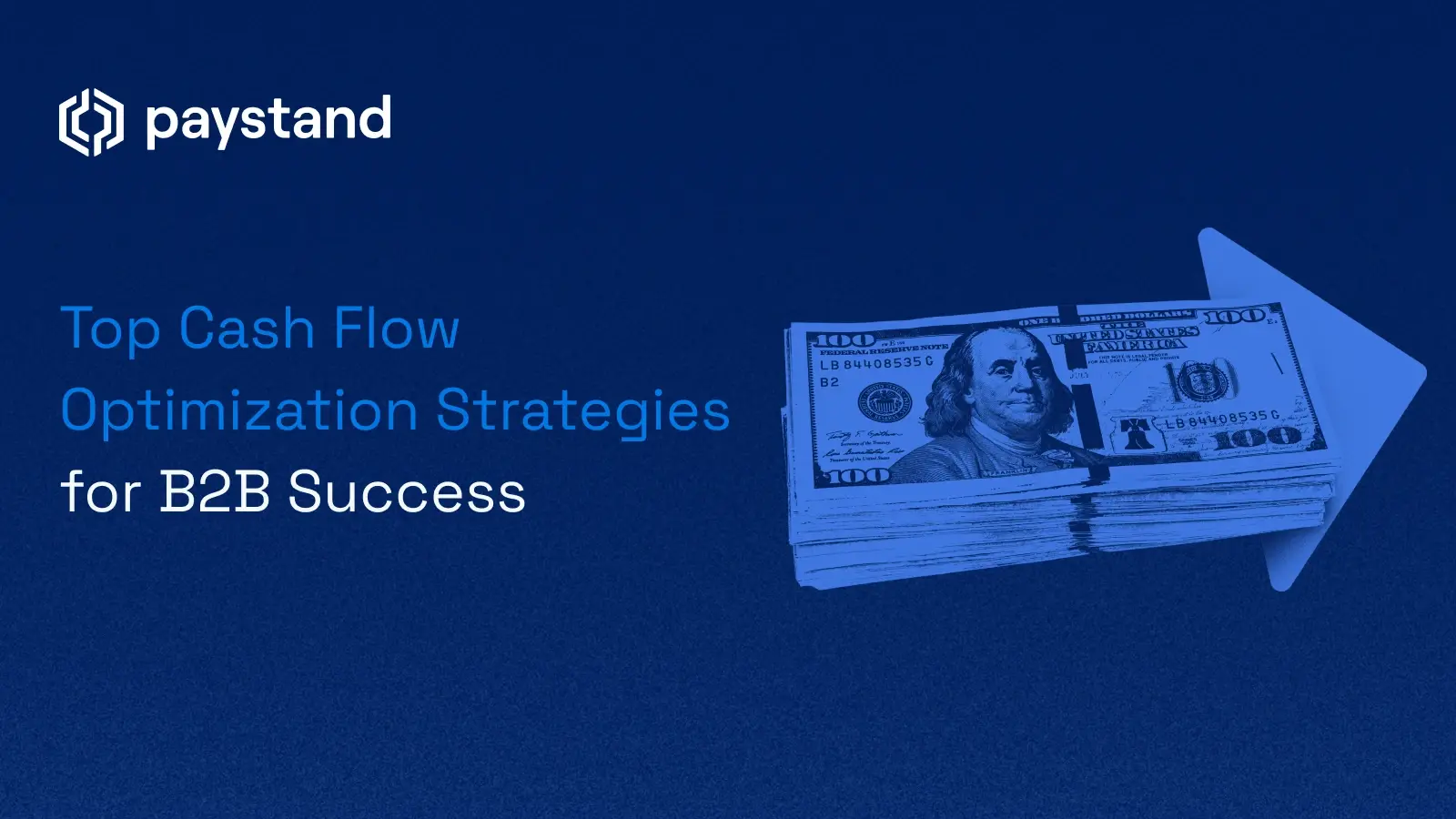Top Cash Flow Optimization Strategies for B2B Success

Table of Contents
- What is Cash Flow?
- Why Optimizing Cash Flow Matters More Than Ever
- Understanding What Drives Cash Flow
- The real cost of manual cash flow management
- How to improve cash flow: 7 tips for success
- The future of cash flow is autonomous
Key Takeaways
- Cash flow optimization is vital for business survival and growth in today’s environment of tight margins, long payment cycles, and economic volatility.
- Many companies still use outdated manual processes for managing cash flow, causing delays, errors, and missed opportunities.
- Effective cash flow strategies emphasize automation, real-time forecasting, streamlined debt collections, and flexible payment options to enhance working capital.
- Replacing legacy systems with modern tools like blockchain payment networks and AR automation future-proofs financial operations and empowers finance teams to act strategically.
- Paystand provides a tech-driven solution that removes transaction fees, automates receivables, and integrates with existing systems, turning cash flow from a burden into a competitive edge.
You don’t have to look far to find a business stalled by poor cash flow. From delayed paychecks to missed growth opportunities, cash flow inefficiencies can stifle momentum, even in profitable companies. In today’s business climate, where B2B payments are more complex, customer expectations are higher, and margins are tighter, optimizing your cash flow isn’t just smart; it’s essential for long-term success.
Yet, despite its significance, cash flow optimization is still often seen as a reactive, spreadsheet-driven task. However, the era of static cash flow statements and late-night number crunching is coming to an end. The companies that are succeeding today, and those poised to lead tomorrow, are adopting automation, data-driven decision-making, and a proactive B2B payments strategy to enhance working capital and strengthen financial resilience.
But here's a thought-provoking question: Are your cash flow strategies truly optimized for today's dynamic business environment? Let's explore further.
What is Cash Flow?
Cash flow is the cash a business earns or spends over time. Measuring cash flow provides transparency into operations, helping identify sources of cash inflows (from sales, fees, investors, or loans) and calculating current and future outflows that reduce these amounts.
It’s important to understand that cash flow and profitability are not the same thing. While profitability indicates how the company is performing overall in relation to its income and expenses, cash flow reflects short-term liquidity. A business can be profitable yet still experience negative cash flow. Conversely, it's possible to have positive cash flow while being unprofitable. When assessing the health of your enterprise, it’s crucial to consider both cash flow and profitability.
Why Optimizing Cash Flow Matters More Than Ever
Cash flow reveals a company’s survival ability. In a high-interest-rate environment and volatile economy, even profitable companies can face cash shortfalls. Unlike profitability, which can be manipulated, cash flow shows real liquidity: usable money.
Rising borrowing costs, supply chain disruptions, and longer B2B payment cycles pressure businesses to enhance working capital without external financing. Optimization now involves gaining cash flow visibility, automating receivables and payables, and utilizing real-time data for informed financial decisions.
Financial leaders face tougher questions: How much cash is needed next quarter? How long can we sustain with current inflows? Which customers cause a DSO spike? These require proactive, tech-enabled answers, not just monthly reconciliations.
Understanding What Drives Cash Flow
Cash flow is oversimplified as “money in, money out,” but it involves operational efficiency, customer behavior, and strategic decisions. Small lags in accounts receivable management, unmonitored subscriptions, or rigid payment terms can escalate into major liquidity issues.
Revenue timing, invoicing accuracy, dispute resolution speed, and payment flexibility impact cash movement. Manual billing, paper checks, and outdated systems create friction, particularly in B2B ecosystems with large, complex transactions.
Moreover, reliance on credit cards introduces fees, while rigid payment infrastructure hinders finance teams from accommodating customer preferences or reconciling payments. The result? You waste valuable time and working capital instead of fueling growth.
A modern B2B payments strategy identifies bottlenecks and reengineers the process using automation, transparency, and intelligent forecasting.
The Real Cost of Manual Cash Flow Management
Spreadsheets may seem tidy, but they hide significant risks. Manual reconciliation and outdated processes cause delays, increase errors, and hinder confident forecasting, making your finance team reactive rather than strategic.
Manual cash flow management leads to fragmented data, delays in AR and AP visibility, and reliance on guesswork for financial standing. This fragility puts CFOs and controllers under pressure during economic shifts or unexpected costs.
Beyond inefficiency, there’s a major opportunity cost: time your finance team spends analyzing trends, managing risk, or planning for growth is wasted on redundant tasks. In high-volume environments, these inefficiencies compound quickly.
A smart approach rebuilds the process rather than just patching cracks. Automating receivables and payment tracking allows finance teams to eliminate human error, reduce DSO, and shift their focus from clerical work to strategy.
How to Improve Cash Flow: 7 Tips for Success
There are many ways to generate cash flow, but how do you know where to start? Here are seven powerful cash flow management strategies that you can start implementing right away.
1. Automate Your Accounts Receivable
Late payments consistently drain working capital. Rather than pursuing them manually, leading finance teams are adopting AR automation.
Automated invoicing, reminders, and digital payment portals reduce delays, eliminate errors, and enhance customer experience. You’re not just speeding up collections; you’re creating a frictionless payment journey.
2. Incentivize Faster Payments
Why wait 45 days to get paid when you can receive payment in just 5? With the right incentives, like early payment discounts, credit card acceptance, or flexible digital payment options, customers are more likely to pay promptly. However, incentives only work when they’re visible and integrated into the process.
Modern platforms enable you to present payment options and rewards at the point of invoicing, not weeks later (e.g. push payments). It’s all about guiding behavior in real time.
3. Use Real-Time Cash Flow Forecasting
If your cash flow forecast is in a spreadsheet and updated monthly, you’re flying blind. Real-time forecasting tools track expected inflows and outflows over various time horizons. They aid in scenario planning: What if a customer delays payment by 30 days? What if supplier terms change?
Automated ERP tools allow cash position projections weeks or months ahead. This foresight helps CFOs avoid shortfalls, optimize credit lines, and time investments strategically.
4. Shorten the Order-to-Cash Cycle
The longer it takes to turn an order into cash, the more strain it puts on your operations.
To optimize this cycle:
- Eliminate approval bottlenecks
- Digitize contracts and POs
- Automate invoice generation based on milestones or fulfillment
- Collect payments electronically with multiple options
A shorter order-to-cash cycle not only enhances cash flow but also fosters trust with customers and provides your team with more time to concentrate on strategic initiatives.
5. Streamline Accounts Payable
Paying slowly isn’t always wise, but paying strategically is. Utilize your payables to your advantage. This can involve extending payment terms (with supplier consent), consolidating vendors, or timing disbursements in alignment with expected inflows. The goal? Preserve vendor relationships without overextending your cash position.
6. Replace Legacy Payment Systems
Legacy payment rails, such as checks and wires, introduce unnecessary delays and costs. Even worse, they create a nightmare for reconciliation. Replacing them with blockchain-based B2B payment networks (like Paystand’s) can eliminate transaction fees, automate reconciliation processes, and transfer money at the speed of the internet rather than through the mail. It’s not just about optimizing cash flow; it’s about future-proofing how money moves.
7. Issue Invoices With Clear Payment Terms
If you’re not sending invoices promptly, you’re harming cash flow. Delays in requesting payment can damage your business. Customers will postpone until invoiced, so ask for payment. Clearly state due dates on invoices, whether immediate, net 15, net 30, or another schedule. If issuing invoices quickly is a challenge, assess your invoicing system. With various software options, you can generate and send invoices efficiently and affordably.
The Future of Cash Flow Is Autonomous
Looking ahead, cash flow management will become more autonomous. As AI, blockchain, and smart contracts advance, finance teams will shift from managing inputs to orchestrating outcomes. Automating receivables collections, payment routing, and dispute resolution will ensure continuous cash flow optimization in the background.
This isn’t tech for tech’s sake; it empowers finance teams to lead, not just report. Companies using autonomous finance systems gain faster reconciliation, real-time cash flow visibility, and reliable forecasting without increasing headcount or overhead.
To optimize cash flow, Paystand offers a transformative solution. By integrating blockchain, automation, and smart contracts, Paystand resolves traditional financial system challenges through key features like:
- Zero transaction fees: Eliminates per-transaction costs through its B2B payment network, enhancing profitability.
- Automated accounts receivable: Streamlines invoicing and collections, reducing manual efforts.
- Real-time payment tracking: Offers visibility into payment statuses, aiding in cash flow forecasting.
- Flexible payment options: Supports various payment methods, catering to diverse client preferences.
- Integration capabilities: Seamlessly connects with existing financial systems, ensuring a unified approach to cash management.
In today's fast-paced financial landscape, sticking to outdated systems hinders progress. Adopting modern payment optimization strategies is essential. By confronting legacy systems, Paystand helps businesses regain financial control, make informed decisions, and foster growth.
Are you ready to revolutionize your financial operations and unlock unprecedented growth? Discover how Paystand helped Penntek Coatings increase their annual transaction volume by transforming their cash flow management and envision the possibilities for your business.




